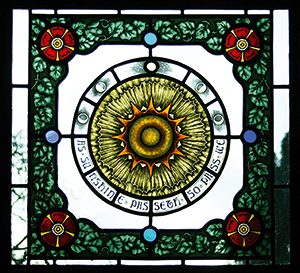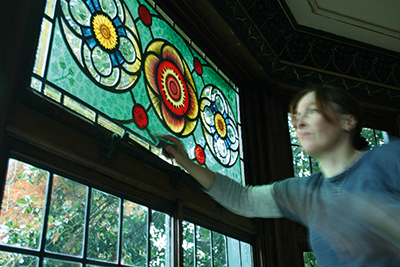Manchester turns to its own for stained glass replacement
 When it was decided to commission new ornate stained glass for The Old Parsonage – a Grade Two-listed building in Didsbury, Manchester – the obvious choice for the job was Manchester-based Genesis Stained Glass. The building, which dates from around 1650, was owned by Alderman Fletcher Moss from 1885 to 1919.
When it was decided to commission new ornate stained glass for The Old Parsonage – a Grade Two-listed building in Didsbury, Manchester – the obvious choice for the job was Manchester-based Genesis Stained Glass. The building, which dates from around 1650, was owned by Alderman Fletcher Moss from 1885 to 1919.
Fletcher Moss was an avid art and nature-lover, who tried his hand at designing his own stained glass. The result was a flamboyant, decorative interior with ornate Gothic-style stained glass and wooden tracery in most of the windows. He bequeathed the building to the people of Manchester and it is now managed by Didsbury Parsonage Trust.
Unfortunately, much of his original stained glass and wood framing mysteriously disappeared after his death. One of the features was an unusual working stained glass sundial in the drawing room, which included the motto ‘As Sunshine Passeth, So Pass We’.
Genesis Stained Glass was asked to replace the missing sundial and two other window panels with new contemporary stained glass, sympathetic to the original but to fit newer, less ornate frames. The task involved many hours of research in the John Rylands Library in Manchester, which holds most of the writings of Fletcher Moss and old photographs of The Old Parsonage.
Jayne Ford, manager of Genesis Stained Glass, who has a research degree, explained: “We welcome projects that involve recreating historical windows and take care to research them fully. We source original images or descriptions of missing glass where possible, to make sure it is true to the original.
 “It’s always a journey of discovery researching the history of our old buildings; the great thing about The Old Parsonage project was that we were allowed a lot of creative freedom, too, in interpreting the original designs.”
“It’s always a journey of discovery researching the history of our old buildings; the great thing about The Old Parsonage project was that we were allowed a lot of creative freedom, too, in interpreting the original designs.”
The result was three windows reflecting the originals – including the Tudor rose and oak motifs much favoured by Fletcher Moss.
For the missing sundial window in the old library, the brief was simply to design a window in the spirit of the original, without re-instating the sundial function. The new window was painted, stained and etched at Genesis Stained Glass in a style celebrating the original, by including the motto painted around a radiant sun at the centre of the points of the clock. A waxing and waning moon symbol was used to suggest the passage of time.
In the larger windows of the old drawing room, the original wooden tracery shapes were suggested by similarly shaping the lead lines of the stained glass. The result was a magnificent ‘Rose in Splendour’ panel and an exquisitely detailed oak motif panel. Both included silver-stained detail, exactly as in the original windows.
Genesis Stained Glass also carried out restoration work on some of the existing stained glass of The Old Parsonage, installing it at the same time as the new windows.
The company welcomes enquiries for any style of stained glass – from large-scale abstract installations to formal memorial windows and detailed figurative work.
 The studio is set up to provide a variety of construction methods, from traditional kiln-fired hand-painting and etching to more contemporary techniques such as lamination, fusing and printing. For example, digital imaging techniques can be used to convert any image or design into permanent imagery in architectural glass.
The studio is set up to provide a variety of construction methods, from traditional kiln-fired hand-painting and etching to more contemporary techniques such as lamination, fusing and printing. For example, digital imaging techniques can be used to convert any image or design into permanent imagery in architectural glass.
That can be combined with traditional stained glass construction in newly-commissioned work for a more up-to-date look that is in keeping with the fabric of the building.
Genesis also provides a restoration and repair service, for both painted and non-painted glass. They work closely with the client to ascertain the level of intervention required, whether it is for retaining 100% of the original glass and lead or replacing badly damaged pieces with accurate reproductions. External polycarbonate, steel-mesh screens or sealed units can also be installed if needed.
A notable project in the future is to produce a second HMS Conway memorial window in Wales, following the installation of the highly-regarded window at the Grade Two-listed Garth Pier in Bangor last year. HMS Conway was a naval ‘school ship’ that ran aground in the 1950s after being moored for many years in North Wales.
The first memorial window was produced by Jayne Ford at Genesis Stained Glass using traditional glass-painting techniques, for the charity Friends of HMS Conway. It was unveiled by Lord Rupert Paget in the presence of the Mayor of Bangor and many old and new cadets. The second Conway memorial window will be at Plas Newydd on Anglesey – her last mooring place before she ran aground in 1953.
For further information call 0161 327 0805 or 07974 307 094, email This email address is being protected from spambots. You need JavaScript enabled to view it. or visit the website at www.genesisstainedglass.co.uk















